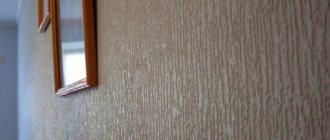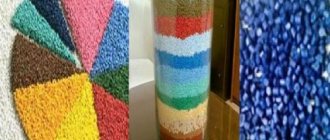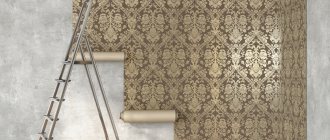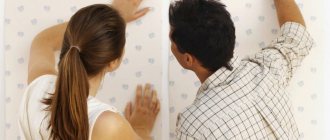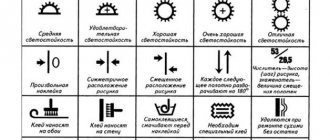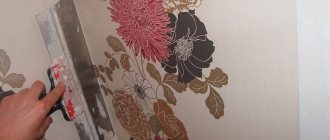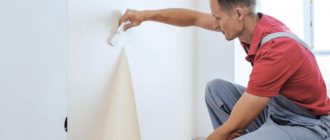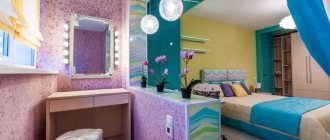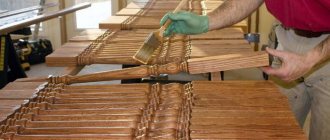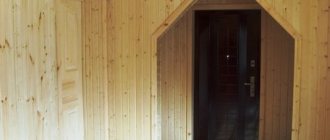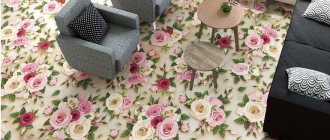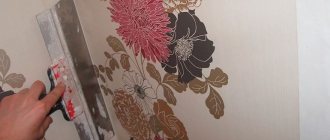The popularity of vinyl wallpaper is due to its durability and beauty. After the appearance of these decorative products on the market, the approach to wall decoration has changed noticeably. Nowadays, relief and advanced design are in fashion. Vinyl wallpaper is made with a base of paper or non-woven fabric. The coating can be smooth or textured. In addition to painted options, the market offers products in white and pastel colors. Ordinary people sometimes wonder whether it is possible to paint vinyl wallpaper - painting is allowed. Some modifications have corresponding markings, and their appearance “speaks” of incomplete readiness and the presence of room for “maneuver”. At the same time, many types of paints will not work. The final choice of solution depends on the characteristics of the material available in its description. Vinyl wallpaper is suitable for all types of rooms, except bathrooms. Canvases are sometimes repainted to update the interior.
Types of vinyl wallpaper
The finishing material is distinguished by the outer layer and the base. It is made from various raw materials. Durability depends on the outer layer, as does aesthetics. Designations of varieties are present in the form of letter markings and pictograms on labels. The abbreviation BB is used for foamed vinyl. The abbreviation PV refers to wallpaper with a top layer of flat vinyl (smooth decorative). Materials with a pronounced texture and decorative relief have the PB marking. Wallpaper with a structured surface for painting is designated STR. In parallel, another classification is used. It includes wallpaper made of foamed vinyl, smooth kitchen. But there are two types that are not distinguished in the first classification. These are silk-screened coatings and heavy vinyl materials. For each type of premises, the most suitable and non-recommended options are highlighted.
How to prepare for work?
Before painting the wallpaper with water-based paint, you need to prepare all the necessary materials. To work you will need the following:
- paint roller (long pile);
- velor roller (for embossed wallpaper);
- flat brush 6-7 cm wide;
- roller cuvette;
- masking tape;
- water-based paint (white base);
- color.
You can tint purchased white paint directly in the store. Large companies offer a computer shade selection service. The specialist will calculate the amount of dye needed to obtain a suitable color. The information will be saved in the program’s memory: using the shade number, you can order an additional volume of the same color if repairs are required or there is not enough material.
If the wallpaper has already been pasted and is being repainted, then before starting work you should wipe the surface with a damp cloth. This will help remove dust and other contaminants that could leave streaks on the new coat of paint or prevent the paint from laying flat (grease stains). The cleaned surface must be dried for 1-2 hours, and then proceed to painting the walls.
Pros and cons of painting
For gluing, you do not need to carefully prepare the coating. Embossed wallpaper, for example, will hide imperfections and roughness. But for subsequent painting, wall treatment will be required. Ignoring this rule will lead to peeling and cracking. But at the same time, if residents want to change the decor and paint the wallpaper a different color, then the new solution will fit normally on the old coating. The dyes are made hypoallergenic and environmentally friendly. Not least because of this, people began to abandon wallpaper on an unnatural basis. But after the invention of canvases based on algae, bamboo, raffia, reed, paints with chemical compounds are already harmful in the sense that they “interrupt” the properties of the environmentally friendly coating. The way out of this situation is to paint only with natural pigments. A noticeable disadvantage of painting is expressed in the low resistance of surfaces to contamination. We are talking about fatty traces and stains.
Benefits of coloring:
- interior improvement;
- hiding wallpaper imperfections;
- wide choice of colors and the ability to change them.
Conclusion
Now you know whether vinyl wallpaper can be painted and how to do it correctly. But before you get started, I recommend watching the video in this article. And if you haven’t found the answer to a question on the topic raised, ask it in the comments, and I will be happy to answer you.
Did you like the article? Subscribe to our Yandex.Zen channel
July 23, 2022
Paint,Wallpaper
If you want to express gratitude, add a clarification or objection, or ask the author something, add a comment or say thank you!
Features of paint selection
First, choose a painting method. Then comes the turn of the solution itself: determining the appropriate type of paint and the ideal color for each room. Buy paint that is water-based, and the oil-based option is definitely not suitable. Acrylic, water-based, dispersion and latex are suitable for covering vinyl wallpaper. Among all these types, acrylic has the advantage. Some masters are inclined to use a combination of acrylic and latex bases. Resistance to fading, detergents, ultraviolet radiation, color change, and contamination is important for the dye. You should buy pigments that form a durable and dense coating. Dyes must dry quickly and not release hazardous compounds. Many interesting options are also not suitable for painting vinyl wallpaper, including silicate, adhesive, enamel and alkyd solutions.
How to paint?
Wallpaper and paint have been selected, and next comes painting. Before you begin, you should choose a paint application method:
- before wallpapering. In this case, the paint is applied to the wallpaper strips before gluing them to the wall. It is necessary to cut the panel of the required length from the roll, apply paint and after drying (after about an hour) begin gluing;
- If the wallpaper has already been glued, then you should wait until the glue has completely dried (the drying time is usually indicated in the instructions for it), and only then paint it.
Methods, technologies and rules of coloring
Vinyl wallpaper is made from non-woven fabric and paper. The principle of painting depends on the material. In turn, there are only 4 methods of coloring: before gluing, after gluing, with wiping, with the creation of a selective pattern. In the first case, the cut strips are painted, and only an hour later they are used to cover the walls. The method allows you to create convex patterns. Raised elements will take up more paint, resulting in a darker design on a light background. The method of applying dye after gluing is needed for smooth surfaces, for maximum uniform distribution. Unusual designs are created using a stencil. The wiping option provides a similar algorithm, but the applied substance is then wiped with a rag to lighten the background. The process will require the effort of two people: one will apply the paint, and the second will wipe it. The last coloring method involves applying a pattern on top of the main background.
The most suitable wallpapers are:
- Kitchen.
- With foamed vinyl.
When purchasing, it doesn’t hurt to check whether the wallpaper is suitable for double-sided painting, because this is an additional opportunity for color formation.
The nuances of painting paper-based wallpaper
There are a couple of key aspects to remember. Firstly, if paper vinyl wallpaper has a fine structure, then painting can cause it to tear, swell, peel, lose color or become soggy. Even if they are tightly glued to the surface. In some cases, the canvas may come off. Plain paper wallpaper, in principle, cannot be painted. It is better not to draw options with o yourself, especially if you have not had such experience before. It would be better to use the services of a specialist. Several paint options are suitable, but it is better to limit yourself to water-based paints. Paintable paper wallpaper is usually made with an uneven surface to retain paint. There are white versions on sale, as well as light green, blue and beige. These desaturated colors can easily be hidden by background paint.
The nuances of painting non-woven wallpaper
Working with non-woven options will be an easy task. Moreover, the paintable material can withstand up to 10 color changes, each time to a more saturated shade. Products with foamed vinyl absorb pigments better than other options. Wallpaper for kitchens is also suitable. A spray bottle is considered the best means for applying the solution to non-woven fabrics: it covers structured and smooth wallpaper equally well. In other cases, the layer of paint will need to be leveled many times. The problem is corrected by priming the surface under the wallpaper. Moreover, for coloring paper canvases, these measures may be useless. The pigment is applied to non-woven products using any of the known methods. Canvases made from this material can also be wiped clean. Applying a coloring solution to non-woven wallpaper will become even easier if there is an insulating backing on the wall.
Before gluing
This method is sometimes accompanied by difficulties. Applying paint to a decorative surface will be more difficult than, for example, to a smooth non-woven base. In the second case, the drawing will be more accurate, and it will take much less time. Wallpaper is glued after complete drying. The coloring matter is selected in rich, deep colors, since the final appearance of the walls will be lighter than on painted canvases. In any case, vinyl wallpaper can be covered with an additional layer. The sections are painted at one time and without distraction - this ensures an even color. In this case, the solution in the container will not thicken during constant use: rollers and brushes will not stick to the canvas and will not spoil the smooth background. You should not create striped or complex designs before gluing if the skill is not sufficiently developed. For wallpaper made of paper, the method may be too inconvenient, but for non-woven wallpaper this is the easiest way.
After pasting
This algorithm is used in cases where it was not possible to decide on the color, or when there is a shortage of space for placing the cut strips. The second problem is solved by processing the canvases one by one, but then a lot of time is lost, and the quality of the final coating is reduced. Including in terms of color. The described situation is relevant for all small apartments. So, on a wallpapered wall, the first thing to do is paint the corners and joint lines. Then wider lines are formed near them, and immediately after this, using active amplitude movements, the pigment is applied to the entire vinyl covering of the wall. Each vertical surface of the room is treated in turn. Paint brushes with the required bristle length are selected to match the textured pattern of the paintings. Volumetric patterns are painted with zigzag movements, alternating them with straight ones. A total of two layers are applied, the second one an hour after the first. The top one should be thinner.
With rubbing
Painting with rubbing begins with wallpapering, as in the method described above. Rubbing is often used to enhance the contrast between the base color and the surface pattern. Despite the fact that the top layers of the coating should be painted better, vinyl absorbs pigments weaker and slower than a base made of non-woven or paper. The color of the picture will be lighter, but the color scheme will remain the same. But rubbing will enhance this difference. To do this, use a rag: purchase a special one or simply find a soft one, without roughness. The order of work usually looks like this: one person only paints, the other only wipes. The process will be labor-intensive, because in order to make a beautiful drawing and maintain color uniformity, you will need a lot of movements. At the same time, care is needed so as not to damage the wallpaper.
Selective drawing
The method is actually an additional option to all of the above options. The drawing is formed after creating the main background. First of all, apply two layers of paint and, if desired, several additional ones. Then the textured pattern is highlighted in a different color. In this regard, mashing will not hurt. The texture is freed from paint, and then, with a paint brush, it is painted in a different color or in several tones at once. For example, if the canvases have patterns in the form of birds, then the eyes, wings and feathers are colored differently. The whole process will take at least a day, sometimes up to a week. The technique is used for decorative options in a modern style. Creative people will like this method. Those with drawing skills can generally add their drawings to the surface of textured wallpaper, but smooth ones are more suitable for this.
Among wallpapers with fine pattern increments, you should choose options with a drip structure.
What wallpaper can be painted with water-based emulsion?
The choice of water-based paint for wallpaper is dictated primarily by its price. Mixtures based on latex or polyvinyl acetate are also suitable for paintable wallpaper, but are a little more expensive. Water-based dye has long been known to Russian residents, is familiar and relatively cheap. Among its other advantages:
- possibility of tinting the white base in any shade;
- resistance of the painted surface to fading and abrasion;
- easy to clean (can be wiped with a damp cloth to remove dirt);
- environmental friendliness;
- no pungent odor upon application.
High-quality material has good hiding power. You can apply just 1 layer of water-based emulsion and get an excellent result when painting wallpaper. But for an ideal effect, you should paint the wall twice, drying the first layer of coating for the time specified by the paint manufacturer.
Painting tools
You can’t do without a brush and a roller, and in addition to these basic tools, you will need stencils and various molds and patterns. The main pigment is applied with rollers and wide brushes, while medium and narrow brushes are used for more precise strokes. The solution is also applied using spray guns and spray guns. But a foam coat is usually not used. Stencils protect various areas from painting, revealing the necessary ones. For painting you will need a painting tray and tape, a soft rag, and protective equipment - a hat, special glasses and rubber gloves. Masking tape is used to insulate all joints between walls and baseboards, floors, window openings and doors. Oilcloth is used to protect furniture. Lay newspapers, paper or film on the floors. In corners and joints, the dye is applied with the smallest brush.
You may also need:
- paint stirrer (usually enough application agent);
- different pads;
- suede ball.
Fiberglass wallpaper
They are best suited for dyeing. To highlight the relief, painting can be done in several layers:
- apply 2 layers of base paint of the desired shade;
- After drying the base, use a velor roller to highlight the protruding parts of the pattern with a different color.
Shades for this coloring are chosen according to taste. You can keep the pattern in a single color scheme, but contrasting shades look no less impressive.
Fiberglass wallpaper can be repainted up to 10 times. This makes repairs easy and economical. If you want to refresh the interior, you can quickly cope with the task by repainting part of the surface or highlighting one wall.
You can even paint ordinary non-woven and thick paper wallpapers that are not intended for this. But the paint will stick worse on vinyl film, so when choosing, you should pay attention to the labeling of the wallpaper.
| Surface preparation: |
| Paint preparation: |
| Painting: |
A few little secrets
To make painting with your own hands as simple as possible and the result to be acceptable, you should take into account the advice of professionals. They recommend the following points:
- The best tool for reusable painting of canvases is a spray gun. It helps to obtain a thin and even layer, on which it will be easier to apply a new one, and such an “extra” will look beautiful in appearance;
- For training, it is advisable to start painting in areas where there is furniture, which can then cover all the defects;
- If the wallpaper is to be glued to the ceiling, then it is optimal to use wide ones; they must be painted in two layers;
- Do not forget that only foamed vinyl is suitable for painting;
- Paint the ceiling first, then the wall.
The best tool for reusable painting of canvases is a spray gun.
Some types of vinyl wallpaper can be painted; painting can be done several times. For this reason, they are popular, because updating the interior occurs quickly and without high costs. The painting process is simple, you can do it yourself. At the same time, different designs and effects can be made on the surface.
Offers from manufacturers
The paint on the surface of the wallpaper not only serves as a decoration, but is also used as a protective layer. Therefore, the chemical composition of the CM, which is suitable for a certain type of surface, is taken into account.
Alkyd-based CM from brands is applied:
- Technolak 50;
- Lakra.
Water-based or latex dyes from leading manufacturers are used:
- Dulux, an international brand based in the UK;
- Beckers, Italy;
- Tikkurila, Finland.
Universal acrylic, which is applied to wallpaper, is marked on the container: “VD-AK”. A coating is formed on the surface that resists exposure to sunlight and can withstand cleaning using detergents.
Marking “VD-VA” means latex. Apply to textured and glass wallpaper. The composition has a special application technology. The coating resists exposure to water.
The table shows dyes often used by consumers. They have proven themselves to be a high-quality coating.
| Brand | Manufacturer country | Price, ruble |
| VGT interior snow-white moisture-resistant 1.5 kg, acrylic based | Russia | 585,00 |
| Tikkurila lumi for interior (waterproof) 9l, acrylate base | Finland | 7752,00 |
| Chief technologist 2.4 kg | Russia | 500,00 |
| Pufas Interior interior moisture resistant, w/d 10 l | Germany | 1150,00 |
| Dulux Diamond Matt / Dulux Diamond Matt Paint for walls and ceilings, water-dispersion matte, 1l | Russia | 915,00 |
| Paint BeckkerPlast 3, Bas VIT, 1 l, latex dye | Switzerland | 720,00 |
| Paint base for tinting Dulux Trade Diamond Matt (Dulax Diamond matte) 1 l | Russia | 725,00 |
| Interior paint Dulux Trade Supermatt white matte – 5 l | Russia | 2507,00 |
| DALI 9l, latex KM | Russia | 295,00 |
Advice from professionals
- If you want to repaint old wallpaper, you need to be careful in choosing the color. Canvases with a pattern can only be painted with dark colors; coatings of bright colors are best painted over with white paint first, and then apply a colored layer.
- The manufacturer's instructions will tell you how many times non-woven wallpaper can be repainted (usually 8-10 stains). But practice shows that you shouldn’t do this more than five times - the appearance will no longer be the same, and the texture will be hidden under layers of paint.
- It is better to paint hard-to-reach places (behind the radiator, under the window sill) with a brush; if the surface is very corrugated, it is more convenient to do this with a foam sponge.
- Not all vinyl wallpaper on a non-woven backing can be painted. Coverings that are embossed, silk-screened or washable for the kitchen will not absorb the coloring pigment. The paint will roll off them rather than lay down in an even layer. Only foamed PVC coatings are ideal for painting.
In principle, anyone can cope with painting non-woven wallpaper - it’s not at all difficult. It is much more difficult to properly cover a room and prepare the walls for painting.
- Do-it-yourself soundproofing of walls
- How to veneer walls with your own hands
- Wallpaper options for the kitchen with photos
- Grouting ceramic tiles
Restrictions
Of course, there are some subtleties, and they relate not only to how to properly paint wallpaper with water-based paint, but also to the condition of the wallpaper itself:
- The wallpaper should sit securely. If they fall off, then nothing will stop them from falling off along with the paint.
- The presence of wallpaper does not deprive you of the opportunity to eliminate identified defects using a primer or even plaster.
- On old wallpaper you will have to apply more layers of paint (not 2, as on average, but 3 or 4). Water-based paint conveys the surface texture well, so defects and abrasions in the wallpaper can show through the coating. Extra layers will help avoid this.
- Wallpaper must be completely cleaned of any dirt.
Where to begin?
- First of all, clean the surface you need from the old finish: remove old wallpaper, decorative plaster, paint. Remove all nails, bolts and sockets.
- It is best to smooth out microcracks, “sinks”, and peelings with putty and sand the surface with sandpaper. This must also be done if there are differences of more than 10 mm per 2 m.
- Prime the walls with penetrating acrylic primer. It will reduce the moisture capacity of the base and strengthen it. Carry out the work in 2 steps, taking a break of 3-4 hours between stages. Acrylic primer can be replaced with wallpaper glue diluted to a liquid state.
- Apply markings for convenience: one vertical line - at a distance of 1 meter from the corner, from the starting line - segments equal to the width of the roll, and vertical strokes for joining the wallpaper.
Advice
Reference! To remove old paint, use a medium-grained abrasive and remove dust with a special product.
The list of tools required for work includes:
- Laser level (plumb line).
- 3 meter tape measure.
- Wide metal spatula.
- Knife.
- Ditches for glue.
- Rollers (rubber - for rolling out wallpaper, with pile - for applying glue).
- A bucket for water, a foam sponge, a simple pencil, a clean towel.
Difficulties of individual areas
Most of the surface of the room is covered with entire strips, cut to the height of the ceiling. Recesses, corners, openings and protrusions create additional difficulties, especially when it is necessary to adjust the pattern.
Pasting in corners
Finishing a corner with a whole strip can lead to the formation of folds and disruption of the perpendicularity of the edge. To make the joint of the canvas smooth, you must:
- Measure the exact distance to the edge of the nearest strip.
- Cut the strip so that its length corresponds to the height of the ceiling, and its width corresponds to the distance to the nearest edge. Both parameters are taken with a margin of 5-6 cm.
- Lubricate the right side of the corner, glue the fabric end-to-end with the left edge of the previous strip. The extra width should fit the wall on the left.
- Determine the area with the smallest overlap. Move 1 cm from its edge to the right, mark and draw a vertical line using a level.
- Along the drawn line, stick the next whole strip of wallpaper.
Pasting in corners may cause wrinkles.
The allowance that extends onto the plinth is cut at the fold. When gluing the inner corners of a room, both canvases are overlapped and then cut with a utility knife.
Wallpapering the ceiling
Before applying the glue, the ceiling is prepared in the same way as the walls. The whitewash is washed off with hot water, the enamel is removed using sandpaper, and the old wallpaper is moistened with a wet roller and removed by hand. If there are visible defects, it is recommended to putty the surface.
After cleaning, the ceiling is coated with a primer and marked using a building level or level. The first strip is glued strictly along the drawn line and smoothed with a roller. The diluted and swollen glue is applied to sections of the ceiling from the middle to the edges.
To finish the ceiling you need 2 people.
The strips are glued to the ceiling and smoothed out.
Tips for other hard-to-reach areas
Difficulties may also arise in areas such as:
- Windows, doors, niches, arches. The wallpaper is cut strictly to the size of the opening. The sides of the niche are covered with whole strips, and the top and bottom are cut to length. If the width of the niche does not accommodate a whole number of stripes, then the outermost side is narrowed.
- Areas behind heating radiators. If it is impossible to remove the installed battery, then cover the area behind it with a small piece of wallpaper. It is cut out according to the size of the area with 5-7 cm of margin around the edges. At the fastening points on the strip, neat vertical cuts are made. The cloth is placed behind the battery and smoothed with a hand with a rag. The allowances are overlapped on the already pasted wallpaper, pressed with a spatula, and then cut off. If there are several fastenings, the area is trimmed with 5-8 narrow strips.
- Places with sockets and switches. Wallpaper is glued over the holes for sockets and switches. After fixing the strip, a cross-shaped or star-shaped cut is made on it (for rectangular and round housings). The ends of the canvas are tucked inside the hole. If the switches cannot be removed, the strip is glued on top and a cross-shaped cut is made in it. Places close to the edge are tucked under the plastic casing, and the remains are removed.
